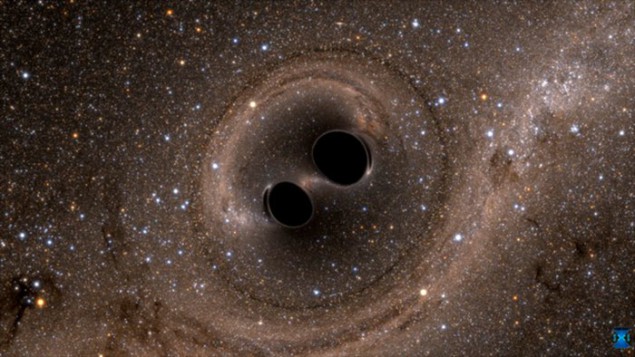
All the gravitational waves so far detected by LIGO have come from mergers of binary black holes, but how such black holes form and pair up is uncertain. Now, researchers in the US and UK have shown that the waves produced when black holes merge can provide significant information about how the pairs formed. The researchers suggest we should have a definitive answer about the origins of black-hole binaries within a few years.
Several theoretical models predict how black-hole binary systems could form. In one, both stars in an isolated binary system collapse to form black holes, which are then drawn into a tighter binary black-hole orbit. Binary black holes formed this way would most likely have their intrinsic angular momenta (or spins) aligned along the axis of the binary orbit.
“To grow up together and then to shrink their orbits, the stars’ atmospheres and cores have to interact tidally,” explains astrophysicist Will Farr of the University of Birmingham. “Tides act to bring their spins into alignment.”
Random orientation
In a second model, two existing black holes are pushed together into an orbit by gravitational interactions with other objects. In this case, the relative orientation of spins of the two black holes would probably be random.
Farr says it is “almost certain” binary black holes form through both methods. “The interesting question is the relative frequency of one type of formation versus the other.” Estimates of the rates of both vary over three orders of magnitude, so the researchers concluded it was unlikely the two rates would be similar enough for the four mergers so far seen from gravitational-wave observations to include binaries formed through different methods. They looked at the “effective spin” of each binary: the vector sum of the spin components of the two black holes, weighted by their masses, along the direction of the binary orbit.
Two black holes with large spin components in the same direction can enter a much closer orbit before finally collapsing together and merging: “As the black holes go around, the stretching and squeezing of space–time oscillates,” explains Farr, “And in those oscillations, you can see the pattern of them approaching each other and plunging as if they were non-spinning or approaching much closer and plunging as if they were spinning.”
Large errors
The researchers studied the distribution of possible effective spins from each event. Although there was a large error on the measurements, all four events had small effective spins. This could result from either intrinsically small spins or spins misaligned with the orbital angular momentum. However, in some events, the effective spin appeared most likely negative: “If [the spins] all point in the same direction, there’s no way to get a negative value,” says Farr. The researchers conclude, therefore, that their results are more consistent with randomly oriented spins, favouring a binary formation model such as the second.
With only four data points from LIGO – three confirmed detections and one possible sighting – they cannot draw firm conclusions. Nevertheless, the researchers suggest that, if future observations have similar uncertainties to those already seen, an additional 10 observations – which may be available within three years – should allow researchers to determine how most black-hole binaries form. “This is, on some level, the first example of what you can do with a population [of gravitational-wave observations],” concludes Farr. “In a decade, we’re going to look back at when we had four events in the can and people were trying to analyse them and think ‘they were the early days: now we’ve got hundreds of them, we do all these sophisticated things and we really understand what’s going on.'”
Squeezing data
Steinn Sigurðsson of Penn State University is impressed by the statistical analysis of gravitational-wave signals: “People used to think we’d need thousands of data points to get the statistics,” he says, “But we’ve got really good at squeezing data and extracting everything we can out of it…The paper’s basically saying ‘We can do a lot with just a few data points’…In some sense it’s what the particle-physics people were doing 20 years ago when they had data and we didn’t.” He cautions, however, that the events may not be representative of all binary black-hole mergers: “With our limited detectors right now we see the biggest bangs,” he says.
Vicky Kalogera of Northwestern University says that “the authors do a very good job of showing that effective spin will be a tell-tale quantity that gravitational-wave measurements will eventually use to reveal what is going on with these binary black holes.”
The research is described in Nature.



